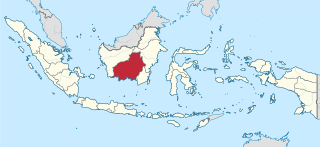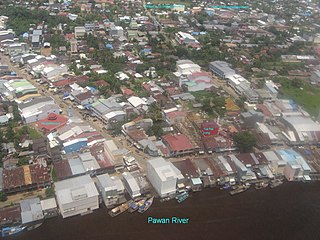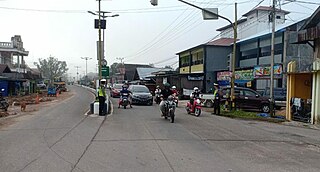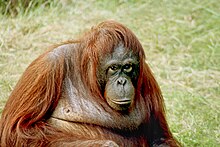
Central Kalimantan is a province of Indonesia. It is one of five provinces in Kalimantan, the Indonesian part of Borneo. It is bordered by West Kalimantan to the west, South Kalimantan and East Kalimantan to the east, Java Sea to the south and is separated narrowly from North Kalimantan and Malaysia by East Kalimantan's Mahakam Ulu Regency. Its provincial capital is Palangka Raya and in 2010 its population was over 2.2 million, while the 2020 Census showed a total of almost 2.67 million; the official estimate as at mid 2022 was 2,741,075.
The Lawa River is a river in East Kalimantan province, Borneo island, Indonesia, about 150 kilometers northwest of Balikpapan. It is a branch of the Mahakam River in eastern Borneo, which is situated entirely within the Kutai Barat, and flows into the Mahakam approximately 200 kilometers (120 mi) upstream from Samarinda. The indigenous communities of Lotaq and Mejaun are situated near its source.
Kumai is a port in Central Kalimantan province in Indonesia, on the island of Borneo. It lies on the Kumai River.

The Kumai River is a river of Central Kalimantan province, Borneo island, Indonesia.

Betung Kerihun National Park is a national park located in the Indonesian province of West Kalimantan, on the island of Borneo. The park was established in 1995, and has a total area of 8,000 km2 (3,100 sq mi) or about 5.5 percent of West Kalimantan Province area. Together with the 2,000 km2 (800 sq mi) Lanjak Entimau Wildlife Sanctuary in Malaysia, it has been proposed to form a World Heritage Site named the "Transborder Rainforest Heritage of Borneo".

Ketapang or Tau-pang in Teochew is the capital city of Ketapang Regency, one of the regencies of West Kalimantan province on the island of Borneo in Indonesia. Ketapang city is located at 1°51′S109°59′E and is a small city on the delta of the Pawan River. Ketapang is served by the Ketapang Airport.

Sampit is a large town located in East Kotawaringin Regency, Central Kalimantan. Previously a timber port town, it has grown to be a medium-sized community with a population of 166,773 according to Statistics Indonesia in 2019, with the economy having since divested from timber products. However, the town is not an autonomous city and not an administrative division by despite having a sizeable population and urban built-up. It consists of 11 urban villages (kelurahan) from Baamang District, Seranau District, and Mentawa Baru Ketapang District. The total area of the town is 751.45 square kilometres.

The Kahayan River, or Great Dayak River, is the second largest river after the Barito River in Central Kalimantan, a province of Indonesia in Kalimantan – the Indonesian part of the island of Borneo. With a total length of 658 km (409 mi) and with a drainage basin of 15,500 km2 (6,000 sq mi) in South Kalimantan, Indonesia. Mean annual discharge 1,178 m3/s (41,600 cu ft/s). The provincial capital Palangkaraya lies on the river. The main inhabitants are Dayaks, who practice slash-and-burn rice cultivation and pan for gold on the upper reaches. The lower Kayahan flows through a rich and unusual environment of peat swamp forests, which has been severely degraded by an unsuccessful program to convert a large part of the area into rice paddies, compounded by legal and illegal forestry.

Tanjung Puting National Park is a national park in Indonesia located in the southeast part of West Kotawaringin Regency in the Indonesian province of Central Kalimantan. The nearest main town is the capital of the Regency, Pangkalan Bun. The park is famous for its orangutan conservation.

Deforestation in Borneo has taken place on an industrial scale since the 1960s. Borneo, the third largest island in the world, divided between Indonesia, Malaysia and Brunei, was once covered by dense tropical and subtropical rainforests.

Pawan River is a major river of West Kalimantan, Indonesia. It has a length of 197 kilometres (122 mi). Tributaries include the Keriau River.

Melawi River is a river in north-western Borneo, Indonesia, about 900 km northeast of the capital Jakarta. It is a tributary of the Kapuas River.
Arut River is a river in the province of Kalimantan Tengah, island of Borneo, Indonesia, about 700 km northeast of the capital Jakarta. It is a tributary of the Lamandau River. The river flows through the north side of Pangkalan Bun town.

Pembuang River or Seruyan River is a river of Borneo, Indonesia. The river has its source near Bikit Tikung in the Schwaner Mountain Range. The eastern side of the river contains dense forest down to Sembulu (Belajau) lakes and is said to be a major habitat of the orangutan. Pembuang means "place of rejection".

West Kotawaringin Regency is one of the thirteen regencies which comprise the Central Kalimantan Province on the island of Kalimantan (Borneo), Indonesia. It originally comprised the whole western part of the province, but on 10 April 2002 the most westerly districts were split off to form the new Lamandau Regency and Sukamara Regency. The population of the residual part of West Kotawaringin Regency was 235,803 at the 2010 Census and 270,388 at the 2020 Census; the official estimate as at mid 2022 was 274,935. The town of Pangkalan Bun in Arut Selatan District is the capital of West Kotawaringin Regency. The regency has an area of about 10,759 km2.

Lamandau Regency is a regency of Central Kalimantan province of Indonesia. The regency was created in 2002 from the northwestern parts of West Kotawaringin Regency. The regency has population of 63,119 according to 2010 census and 97,611 based on 2020 census. Population estimate at mid-2022 was 104,387. The regency covers an area of 7,673.56 square kilometers and divided into eight districts (kecamatan). The regency seat is located at the town of Nanga Bulik, which is the regency's economic and administrative center.

Pangkalan Bun is the capital of West Kotawaringin Regency in Borneo, Indonesia. It has a population of around 200,000 It is also the administrative headquarters of South Arut district (kecamatan).
Sekonyer is a river in southern Borneo, Central Kalimantan province, Indonesia, about 700 km northeast of the capital Jakarta.
Mendawai is an Austronesian language spoken along the lower course of the Arut River in West Kotawaringin Regency, Central Kalimantan, Indonesia. It is at the mutually unintelligible end of a dialect continuum with Ngaju. Mendawai and Ngaju share c. 70% of their basic vocabulary.


















